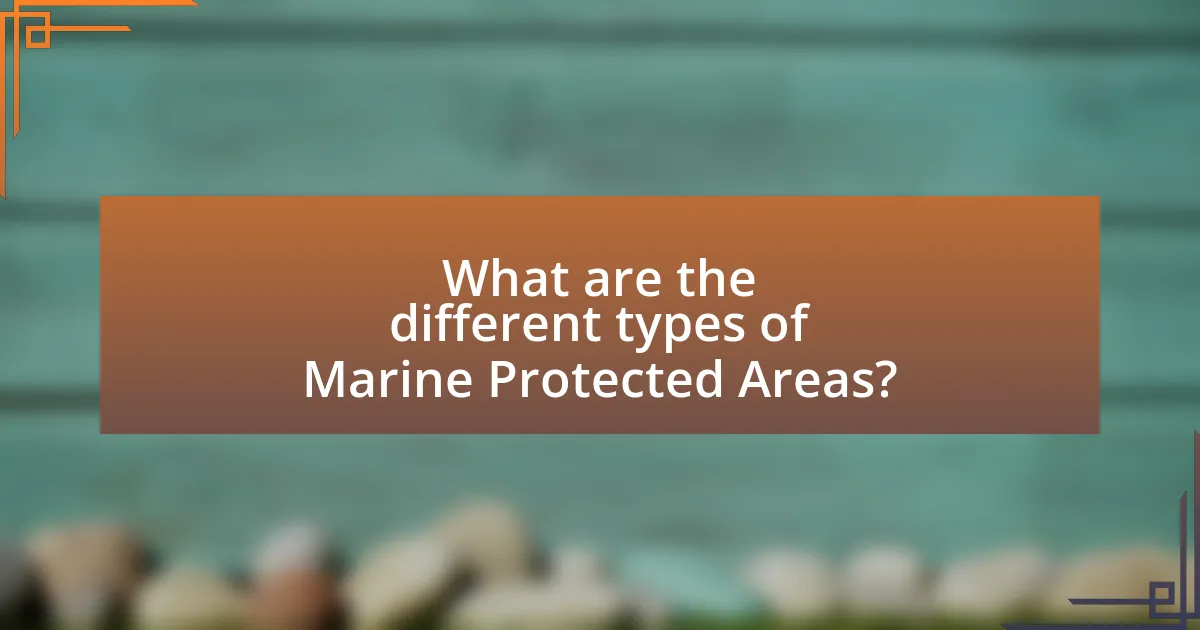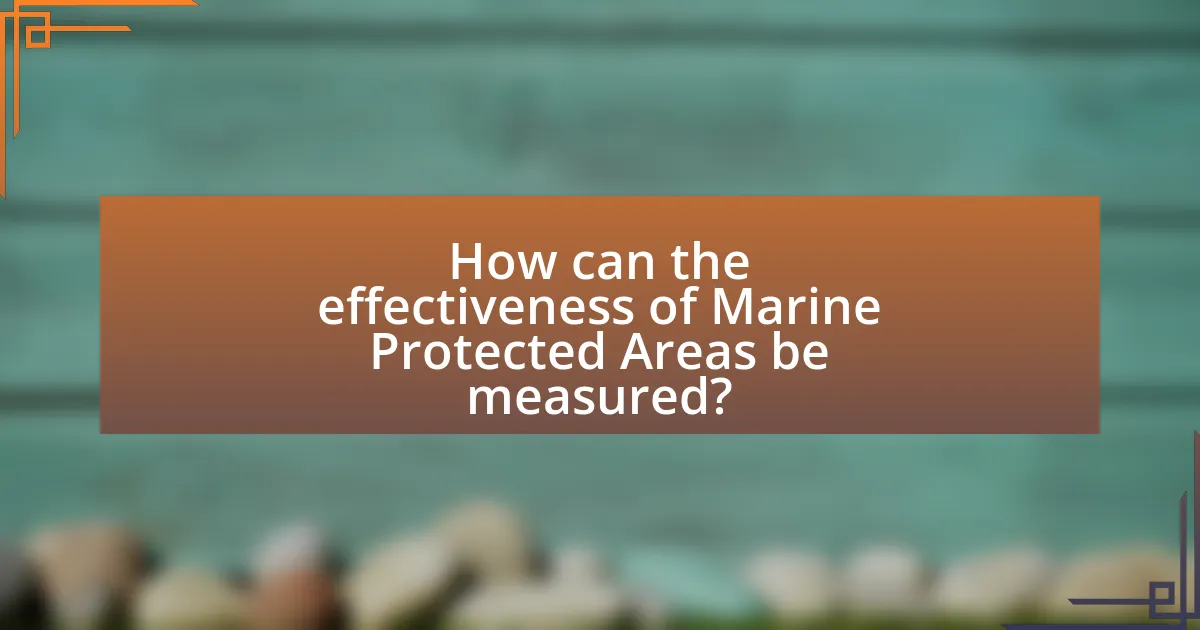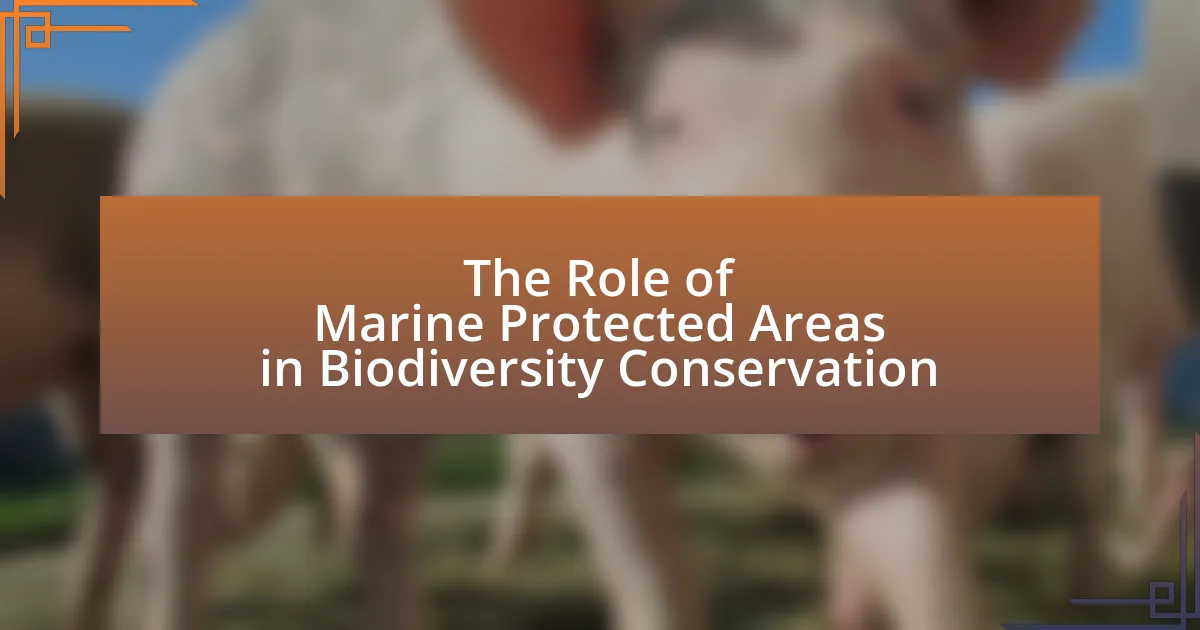Marine Protected Areas (MPAs) are designated regions in marine environments aimed at conserving biodiversity and ecosystems by restricting human activities. This article explores the significance of MPAs in biodiversity conservation, detailing their role in enhancing fish populations, protecting endangered species, and restoring critical habitats such as coral reefs and mangroves. It also examines the various types of MPAs, the challenges they face—including illegal fishing and climate change—and the importance of community involvement and effective management strategies. Additionally, the article highlights the future prospects for MPAs in global conservation efforts and the role of technology and international agreements in expanding these protected areas.
-1.webp)
What are Marine Protected Areas (MPAs)?
Marine Protected Areas (MPAs) are designated regions in marine environments where human activities are restricted to conserve biodiversity and ecosystems. These areas aim to protect marine life, habitats, and ecological processes, thereby enhancing the resilience of marine ecosystems. According to the International Union for Conservation of Nature (IUCN), MPAs can vary in their level of protection, ranging from fully protected marine reserves to areas with regulated activities. Research indicates that MPAs can lead to increased fish populations and biodiversity, with studies showing that well-managed MPAs can boost fish biomass by up to 600% compared to unprotected areas.
How do MPAs contribute to biodiversity conservation?
Marine Protected Areas (MPAs) contribute to biodiversity conservation by providing safe habitats where marine species can thrive without the pressures of fishing, pollution, and habitat destruction. MPAs help to restore and maintain healthy ecosystems, which are essential for the survival of diverse marine life. Research indicates that MPAs can lead to increased species richness and abundance; for example, a study published in “Nature” by Edgar et al. (2014) found that fish biomass was, on average, 2.5 times greater in MPAs compared to non-protected areas. This increase in biomass supports not only the targeted species but also the overall health of marine ecosystems, demonstrating the effectiveness of MPAs in conserving biodiversity.
What types of ecosystems are typically protected by MPAs?
Marine Protected Areas (MPAs) typically protect a variety of ecosystems, including coral reefs, mangroves, seagrass beds, and estuaries. These ecosystems are crucial for biodiversity, providing habitat for numerous marine species and serving essential ecological functions. For instance, coral reefs support about 25% of all marine life despite covering less than 1% of the ocean floor, highlighting their importance in biodiversity conservation. Additionally, mangroves act as vital nurseries for fish and protect coastlines from erosion, while seagrass beds contribute to carbon sequestration and water quality improvement. The protection of these ecosystems through MPAs is essential for maintaining marine biodiversity and ecosystem health.
How do MPAs help in preserving endangered species?
Marine Protected Areas (MPAs) help in preserving endangered species by providing a safe habitat free from human activities such as overfishing and pollution. These designated areas allow ecosystems to recover and thrive, which is crucial for the survival of vulnerable species. For instance, studies have shown that MPAs can lead to increased populations of endangered species, such as the recovery of the Nassau grouper in the Caribbean, where fishing restrictions have led to a significant rebound in their numbers. Additionally, MPAs contribute to biodiversity by protecting critical habitats, such as coral reefs and mangroves, which serve as breeding and feeding grounds for many endangered marine species.
Why are MPAs important for marine life?
Marine Protected Areas (MPAs) are crucial for marine life because they provide safe habitats that promote biodiversity and ecosystem health. By restricting human activities such as overfishing and pollution, MPAs allow marine species to thrive, recover, and reproduce in a protected environment. Research indicates that MPAs can lead to increased fish populations and greater biodiversity; for instance, a study published in the journal “Nature” found that fish biomass in no-take MPAs can be up to 600% higher than in unprotected areas. This enhancement of marine life contributes to the overall resilience of ocean ecosystems, making MPAs essential for the sustainability of marine biodiversity.
What role do MPAs play in habitat restoration?
Marine Protected Areas (MPAs) play a crucial role in habitat restoration by providing a safe environment for ecosystems to recover from human-induced stressors. MPAs limit activities such as fishing, pollution, and coastal development, allowing marine habitats to regenerate and biodiversity to increase. Research indicates that MPAs can lead to a significant recovery of fish populations and the restoration of coral reefs, with studies showing that fish biomass can increase by up to 600% within protected areas compared to unprotected regions. This restoration not only enhances ecological resilience but also supports the overall health of marine ecosystems, demonstrating the effectiveness of MPAs in habitat restoration.
How do MPAs support fish populations and fisheries?
Marine Protected Areas (MPAs) support fish populations and fisheries by providing safe habitats that promote the recovery and growth of fish species. MPAs restrict fishing and other harmful activities, allowing fish to reproduce and thrive in a controlled environment. Research indicates that fish biomass can increase by up to 600% in MPAs compared to unprotected areas, leading to healthier ecosystems. Additionally, the spillover effect from MPAs enhances surrounding fisheries, as adult fish migrate outside protected zones, benefiting local fishing communities. Studies, such as those published in the journal “Ecological Applications,” demonstrate that well-managed MPAs contribute significantly to sustainable fisheries management and biodiversity conservation.

What are the different types of Marine Protected Areas?
Marine Protected Areas (MPAs) are classified into several types based on their level of protection and management objectives. The primary types include:
- No-Take Zones: Areas where all forms of extraction, including fishing and mining, are prohibited to conserve biodiversity and allow ecosystems to recover.
- Marine Reserves: Regions designated for the protection of marine life, where human activities are limited or regulated to ensure the preservation of habitats and species.
- Multiple-Use MPAs: Areas that allow for a variety of human activities, such as fishing, tourism, and recreation, but with regulations in place to minimize environmental impact.
- Special Management Areas: Regions that focus on specific conservation goals, often addressing particular species or habitats that require targeted protection efforts.
- Community-Conserved Areas: MPAs managed by local communities, emphasizing traditional knowledge and practices in conservation efforts.
These classifications help in the effective management and conservation of marine biodiversity, as evidenced by studies showing that well-managed MPAs can lead to increased fish populations and healthier ecosystems.
How do fully protected MPAs differ from partially protected ones?
Fully protected Marine Protected Areas (MPAs) prohibit all extractive activities, while partially protected MPAs allow certain regulated activities such as fishing or resource extraction. This distinction is crucial for biodiversity conservation, as fully protected MPAs provide a sanctuary for marine life, leading to increased biomass and species diversity. Research indicates that fully protected MPAs can enhance fish populations by up to 600% compared to unprotected areas, demonstrating their effectiveness in promoting ecological resilience and recovery. In contrast, partially protected MPAs may not achieve the same level of biodiversity benefits due to ongoing human impacts.
What regulations are typically enforced in fully protected MPAs?
Fully protected Marine Protected Areas (MPAs) typically enforce regulations that prohibit all extractive activities, including fishing, mining, and drilling. These regulations aim to conserve marine biodiversity and ecosystems by allowing habitats to recover and thrive without human interference. For instance, studies have shown that fully protected MPAs can lead to increased fish populations and biodiversity, as evidenced by research published in the journal “Nature” which found that fish biomass in fully protected areas can be up to three times higher than in unprotected areas.
How do partially protected MPAs balance conservation and resource use?
Partially protected Marine Protected Areas (MPAs) balance conservation and resource use by implementing specific regulations that allow for sustainable resource extraction while safeguarding critical habitats. These MPAs often designate zones where certain activities, such as fishing or tourism, are permitted under strict guidelines, ensuring that ecological integrity is maintained. For instance, studies have shown that partially protected MPAs can lead to increased fish populations and biodiversity, as seen in the Great Barrier Reef, where regulated fishing practices have resulted in healthier ecosystems. This dual approach allows for the sustainable use of marine resources while promoting conservation efforts, demonstrating that effective management can yield benefits for both biodiversity and local communities.
What are the challenges faced by Marine Protected Areas?
Marine Protected Areas (MPAs) face several significant challenges that hinder their effectiveness in biodiversity conservation. One major challenge is illegal fishing, which undermines conservation efforts by depleting fish stocks and disrupting marine ecosystems. According to a study published in the journal “Marine Policy,” illegal fishing can account for up to 30% of total fish catches in some regions, directly impacting the sustainability of marine resources. Another challenge is insufficient funding and resources for management and enforcement, leading to inadequate monitoring and protection of these areas. Research from the World Wildlife Fund indicates that many MPAs operate with budgets that are less than 10% of what is needed for effective management. Additionally, climate change poses a threat to MPAs by altering marine habitats and species distributions, making it difficult to maintain biodiversity. The Intergovernmental Panel on Climate Change has reported that ocean warming and acidification are expected to have profound impacts on marine ecosystems, further complicating conservation efforts within MPAs.
How does climate change impact the effectiveness of MPAs?
Climate change significantly reduces the effectiveness of Marine Protected Areas (MPAs) by altering marine ecosystems and species distributions. As ocean temperatures rise, many marine species migrate to cooler waters, often outside the boundaries of MPAs, which diminishes the protective benefits these areas provide. Additionally, increased ocean acidification affects coral reefs and shellfish, critical habitats that MPAs aim to protect, leading to declines in biodiversity. Research indicates that over 30% of marine species are at risk due to climate change, highlighting the urgent need for adaptive management strategies within MPAs to address these challenges effectively.
What are the socio-economic challenges associated with establishing MPAs?
Establishing Marine Protected Areas (MPAs) presents several socio-economic challenges, primarily including the displacement of local communities, loss of livelihoods, and conflicts over resource use. Displacement occurs when communities reliant on fishing or tourism are restricted from accessing traditional fishing grounds or coastal areas, leading to economic hardship. For instance, a study by the World Bank highlighted that in regions where MPAs were implemented, local fishers often faced reduced catch and income, which can exacerbate poverty levels. Additionally, conflicts may arise between conservation goals and economic interests, as stakeholders such as tourism operators and local fishers may have competing priorities. These socio-economic challenges necessitate careful planning and stakeholder engagement to balance conservation efforts with the needs of local communities.

How can the effectiveness of Marine Protected Areas be measured?
The effectiveness of Marine Protected Areas (MPAs) can be measured through various ecological indicators, including biodiversity levels, fish biomass, and habitat health. Studies have shown that MPAs often lead to increased species richness and abundance, with research indicating that fish biomass can increase by an average of 600% within fully protected areas compared to unprotected regions. Additionally, monitoring changes in habitat quality, such as coral cover and seagrass health, provides concrete evidence of an MPA’s impact on marine ecosystems. These metrics collectively demonstrate the success of MPAs in conserving biodiversity and enhancing marine life resilience.
What indicators are used to assess biodiversity within MPAs?
Indicators used to assess biodiversity within Marine Protected Areas (MPAs) include species richness, abundance, and diversity indices. Species richness measures the number of different species present, while abundance quantifies the number of individuals within those species. Diversity indices, such as the Shannon-Wiener index, provide a more comprehensive view by considering both species richness and evenness, reflecting how evenly individuals are distributed among the species. These indicators are critical for evaluating the effectiveness of MPAs in conserving marine biodiversity, as they help track changes over time and assess the impact of protection measures.
How do scientists monitor changes in marine populations in MPAs?
Scientists monitor changes in marine populations in Marine Protected Areas (MPAs) through various methods, including underwater surveys, remote sensing, and ecological modeling. Underwater surveys, such as visual census techniques and the use of underwater cameras, allow researchers to directly observe and count species, providing baseline data on population sizes and distributions. Remote sensing technologies, including satellite imagery and aerial surveys, help track changes in habitat conditions and the extent of marine resources over time. Ecological modeling integrates data from these methods to predict population trends and assess the effectiveness of MPAs in conserving biodiversity. These approaches are validated by studies demonstrating significant changes in species abundance and diversity within MPAs compared to unprotected areas, highlighting the importance of monitoring for effective conservation strategies.
What role does community involvement play in evaluating MPAs?
Community involvement is crucial in evaluating Marine Protected Areas (MPAs) as it enhances the assessment process through local knowledge and stakeholder engagement. Local communities often possess valuable insights about marine ecosystems, which can inform the effectiveness of MPAs in biodiversity conservation. For instance, studies have shown that community-led monitoring initiatives can lead to more accurate data collection regarding species populations and habitat conditions, thereby improving management strategies. Furthermore, involving communities fosters a sense of ownership and responsibility, which can lead to better compliance with conservation measures and increased support for MPA initiatives.
What best practices can enhance the success of Marine Protected Areas?
Effective management and stakeholder engagement are best practices that can enhance the success of Marine Protected Areas (MPAs). Implementing adaptive management strategies allows for ongoing assessment and adjustment of conservation measures based on ecological data and stakeholder feedback. Research indicates that MPAs with strong community involvement and clear governance structures are more likely to achieve their conservation goals. For instance, a study published in “Conservation Biology” by Edgar et al. (2014) found that well-enforced MPAs led to a 446% increase in fish biomass compared to unprotected areas, demonstrating the importance of effective enforcement and community support in achieving biodiversity conservation objectives.
How can stakeholder engagement improve MPA management?
Stakeholder engagement can significantly improve Marine Protected Area (MPA) management by fostering collaboration and ensuring that diverse perspectives are considered in decision-making processes. Engaging stakeholders, including local communities, fishers, and conservation organizations, leads to more effective management strategies that reflect the needs and values of those directly affected by MPAs. For instance, studies have shown that MPAs with active stakeholder involvement experience better compliance with regulations and enhanced conservation outcomes, as stakeholders are more likely to support and adhere to management measures they helped shape. This collaborative approach not only increases the legitimacy of management actions but also enhances the adaptive capacity of MPAs to respond to ecological changes and socio-economic challenges.
What strategies can be implemented to ensure compliance with MPA regulations?
To ensure compliance with Marine Protected Area (MPA) regulations, effective strategies include establishing clear guidelines, conducting regular monitoring, and engaging local communities. Clear guidelines provide a framework for acceptable activities within MPAs, which helps stakeholders understand their responsibilities. Regular monitoring, such as ecological assessments and enforcement patrols, ensures adherence to regulations and identifies violations promptly. Engaging local communities fosters stewardship and encourages compliance, as community members are more likely to support regulations that they helped shape. These strategies are supported by studies showing that community involvement and consistent monitoring significantly enhance compliance rates in MPAs.
What are the future prospects for Marine Protected Areas in biodiversity conservation?
The future prospects for Marine Protected Areas (MPAs) in biodiversity conservation are promising, as they are increasingly recognized as essential tools for preserving marine ecosystems. Research indicates that well-managed MPAs can enhance biodiversity, restore fish populations, and improve ecosystem resilience against climate change. For instance, a study published in “Nature” by Edgar et al. (2014) found that MPAs can lead to a 446% increase in biomass of fish populations compared to unprotected areas. Furthermore, the global commitment to expand MPAs to cover 30% of the ocean by 2030, as outlined in the Kunming-Montreal Global Biodiversity Framework, underscores the growing recognition of their importance in conservation efforts. This expansion is expected to provide critical habitats for marine species, support fisheries, and contribute to overall ocean health.
How can technology aid in the management of MPAs?
Technology can significantly aid in the management of Marine Protected Areas (MPAs) by enhancing monitoring, data collection, and enforcement capabilities. For instance, satellite imagery and remote sensing technologies allow for real-time tracking of environmental changes and illegal activities within MPAs, enabling timely interventions. Additionally, the use of Geographic Information Systems (GIS) facilitates spatial analysis and planning, helping managers to visualize and assess the ecological health of marine ecosystems. Drones equipped with cameras can also survey large areas efficiently, providing high-resolution data on wildlife populations and habitat conditions. These technological advancements improve decision-making processes and resource allocation, ultimately contributing to the effective conservation of biodiversity within MPAs.
What role do international agreements play in expanding MPAs?
International agreements play a crucial role in expanding Marine Protected Areas (MPAs) by establishing frameworks for cooperation among nations to conserve marine biodiversity. These agreements, such as the Convention on Biological Diversity and the Paris Agreement, set targets for the protection of marine ecosystems and encourage countries to designate MPAs as part of their commitments to sustainable development and biodiversity conservation. For instance, the Aichi Biodiversity Targets, adopted in 2010, specifically aim for at least 10% of coastal and marine areas to be protected by 2020, which has driven many countries to expand their MPA networks.
